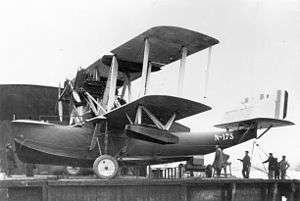Supermarine Swan
The Supermarine Swan was a 1920s British experimental amphibian aircraft built by Supermarine at Woolston. Only one was built and it was used for a passenger service between England and France.
| Swan | |
|---|---|
 | |
| Prototype (N175) with landing gear at Woolston, Southampton. | |
| Role | Flying boat |
| Manufacturer | Supermarine |
| Designer | R. J. Mitchell |
| First flight | 25 March 1924 |
| Introduction | 1926 |
| Retired | 1927 |
| Primary users | Imperial Airways Marine Aircraft Experimental Establishment |
| Number built | 1 |
| Variants | Supermarine Southampton |
Design and development
The Swan was designed by R. J. Mitchell, chief designer at Supermarine as an experimental wooden twin-engined biplane amphibian aircraft, in parallel with the Supermarine Scylla design for a replacement for the Royal Air Force's Felixstowe F5s.[1]
First flown on 25 March 1924 (as serial N175), the Swan was powered by two 350 hp (261 kW) Rolls-Royce Eagle IX engines. It was re-engined with two 450 hp (336 kW) Napier Lion engines and had the landing gear removed for evaluation at the Marine Aircraft Experimental Establishment in August 1924. In 1926, it was registered G-EBJY and loaned to Imperial Airways as a flying boat with accommodation for 10 passengers until it was scrapped in 1927.
Specifications
General characteristics
- Crew: 2
- Capacity: 10 passengers, or 1352 kg (2982 lbs.) of cargo
- Length: 14.78 m (48 ft 6 in)
- Wingspan: 20.93 m (68 ft 8 in)
- Height: 5.57 m (18 ft 3 in)
- Wing area: 117.6 m2 (1,266 sq ft)
- Empty weight: 4,588 kg (10,114 lb)
- Gross weight: 6,219 kg (13,710 lb)
- Powerplant: 2 × Napier Lion IIB inline piston, 336 kW (451 hp) each
Performance
- Maximum speed: 175 km/h (109 mph, 94 kn)
- Cruise speed: 148 km/h (92 mph, 80 kn)
- Stall speed: 72 km/h (45 mph, 39 kn)
- Range: 480 km (300 mi, 260 nmi)
- Service ceiling: 3,110 m (10,200 ft)
- Rate of climb: 2.6 m/s (510 ft/min)
- Wing loading: 52.6 kg/m2 (10.78 lb/sq ft)
See also
Related development
Aircraft of comparable role, configuration and era
Related lists
References
| Wikimedia Commons has media related to Supermarine Swan. |
- Andrews and Morgan 1987, p.87
- Andrews and Morgan 1987, p.95.
- Simmonds, O.E. (25 March 1926). "Development of Civil Aircraft". Flight. XVIII (12): 180–182. Retrieved 21 December 2016.
- Air Pictorial and Air Reserve Gazette. 18 (9). Missing or empty
|title=(help)
- Andrews, C.N.; Morgan, E.B. (1987). Supermarine Aircraft since 1914 (Second ed.). London: Putnam. ISBN 0-85177-800-3.
- A.J. Jackson, British Civil Aircraft since 1919 Volume 3, 1974, Putnam, London, ISBN 0-370-10014-X, Page 315